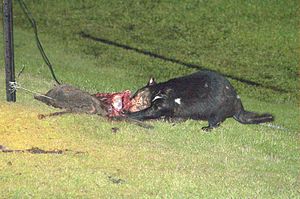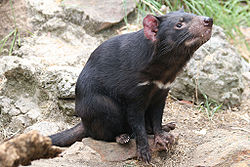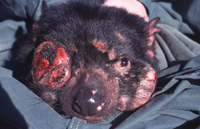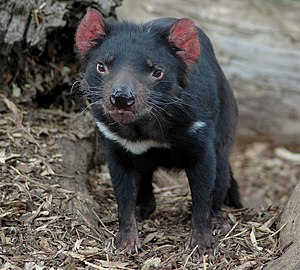AY Honors/Marsupials/Answer Key
Template:Otheruses Template:Taxobox The Tasmanian Devil (Sarcophilus harrisii), also referred to simply as "the devil", is a carnivorous marsupial now found in the wild only in the Australian island state of Tasmania. The Tasmanian Devil is the only extant member of the genus Sarcophilus. The size of a small dog, but stocky and muscular, the Tasmanian Devil is now the largest carnivorous marsupial in the world after the extinction of the Thylacine in 1936. It is characterised by its black fur, offensive odor when stressed, extremely loud and disturbing screech, and viciousness when feeding. It is known to both hunt prey and scavenge carrion and although it is usually solitary, it sometimes eats with other devils.
The Tasmanian Devil became extirpated on the Australian mainland about 400 years before European settlement in 1788. Because they were seen as a threat to livestock in Tasmania, devils were hunted until 1941, when they became officially protected. Since the late 1990s devil facial tumour disease has reduced the devil population significantly and now threatens the survival of the species, which in May of 2008 was finally declared to be endangered. Programs are currently being undertaken by the Tasmanian government to reduce the impact of the disease.
Taxonomy
Naturalist George Harris wrote the first published description of the Tasmanian Devil in 1807, naming it Didelphis ursina.& In 1838 the devil was renamed Dasyurus laniarius by Richard Owen, before being moved to the genus Sarcophilus in 1841 and named Sarcophilus harrisii, or "Harris's meat-lover", by Pierre Boitard. A later revision of the devil's taxonomy, published in 1987, attempted to change the species name to Sarcophilus laniarius based on mainland fossil records of only a few animals.& However, this was not accepted by the taxonomic community at large and the name S. harrisii has been retained and S. laniarius relegated to fossil species.& Phylogenetic analysis shows that the devil is most closely related to quolls, and more distantly to the extinct Thylacine (Tasmanian Tiger).&
Physical description
The Tasmanian Devil is the largest surviving carnivorous marsupial in Australia. It has a squat and thick build, with a large head and a tail which is about half its body length. The devil stores body fat in its tail, so unhealthy devils often have thin tails. Unusual for a marsupial, its forelegs are slightly longer than its hind legs. Devils can run up to Template:Convert per hour for short distances. The fur is usually black, although irregular white patches on the chest and rump are common. Males are usually larger than females, having an average head and body length of Template:Convert, with a Template:Convert tail, and an average weight of Template:Convert. Females have an average head and body length of Template:Convert, with a Template:Convert tail, and an average weight of Template:Convert.& The average life expectancy of a Tasmanian Devil in the wild is estimated at six years, although they may live longer in captivity.
The devil has long whiskers on its face and in clumps on the top of the head. These help the devil locate prey when foraging in the dark, and aid in detecting when other devils are close during feeding. When agitated, the devil can produce a strong odour, its pungency rivaling even the skunk. Hearing is its dominant sense, and it also has an excellent sense of smell. Since devils hunt at night, their vision seems to be strongest in black and white. In these conditions they can detect moving objects readily, but have difficulty seeing stationary objects.& An analysis of mammalian bite force relative to the body size shows that the devil has the strongest bite of any living mammal.& The power of the jaw is in part due to its comparatively large head. A Tasmanian Devil also has one set of teeth that grows slowly throughout its life.&
Reproduction
Females start to breed when they reach sexual maturity, typically in their second year. At this point, they become fertile once a year, producing multiple ova while in heat.& Mating occurs in March, in sheltered locations during both day and night. Males fight over females in the breeding season, and female devils will mate with the dominant male. Devils are not monogamous, and females will mate with several males if not guarded after mating. Gestation lasts 21 days, and devils give birth to up to 50 young,& each weighing approximately 0.18–0.24 grams.& When the young are born, they move from the vagina to the pouch. Once inside the pouch, they each remain attached to a nipple for the next 100 days. The female Tasmanian Devil's pouch, like that of the wombat, opens to the rear, so it is physically difficult for the female to interact with young inside the pouch. Despite the large litter at birth, the female has only four nipples, so that no more than four young can survive birth. On average, more females survive than males.&
Inside the pouch, the nourished young develop quickly. At 15 days the external parts of the ear are visible. Eyelids are apparent at 16 days, whiskers at 17 days, and the lips at 20 days. The young start to grow fur at 49 days and have a full coat by 90 days. Their eyes open shortly after their fur coat develops—between 87 and 93 days—and their mouths can relax their hold of the nipple at 100 days.& They leave the pouch 105 days after birth, appearing as small copies of the parent and weighing approximately Template:Convert. Unlike kangaroo joeys, young devils do not return to the pouch; instead, they remain in the den for another three months, first venturing outside the den between October and December before becoming independent in January. Female devils are occupied with raising their young for all but approximately six weeks of the year.
Ecology and behaviour

Tasmanian Devils are widespread and fairly common throughout Tasmania. Found in all habitats on the island, including the outskirts of urban areas, they particularly like dry sclerophyll forests and coastal woodlands. The Tasmanian Devil is a nocturnal and crepuscular hunter, spending the days in dense bush or in a hole. Young devils can climb trees, but this becomes more difficult as they grow larger. Devils can also swim. They are predominantly solitary animals and do not form packs.& They occupy territories of 8–20 km², which can overlap considerably amongst different animals.

Tasmanian Devils can take prey up to the size of a small wallaby, but in practice they are opportunistic, and eat carrion more often than they hunt live prey. Although the devil favours wombats, it will eat all small native mammals, domestic mammals (including sheep), birds, fish, insects, frogs and reptiles. Their diet is largely varied and depends on the food available.& On average, they eat about 15% of their body weight each day; however, they can eat up to 40% of their body weight in 30 minutes if the opportunity arises.& Tasmanian Devils eliminate all traces of a carcass, devouring the bones and fur in addition to the meat and internal organs. In this respect, the devil has earned the gratitude of Tasmanian farmers, as the speed at which they clean a carcass helps prevent the spread of insects that might otherwise harm livestock.
Eating is a social event for the Tasmanian Devil. Much of the noise attributed to the animal is a result of raucous communal eating, at which up to 12 individuals can gather, and can often be heard several kilometers away. A study of feeding devils identified 20 physical postures, including their characteristic vicious yawn, and the 11 different vocal sounds that devils use to communicate as they feed. They usually establish dominance by sound and physical posturing, although fighting does occur.& Adult males are the most aggressive, and scarring is common from fighting over food and mates.
Conservation status
For some time, Tasmania was the last refuge of large marsupial carnivores. All of the larger carnivorous marsupials became extinct in mainland Australia shortly after humans arrived. Only the smallest and most adaptable survived. Fossil evidence from western Victoria shows that Tasmanian Devils retained a place on the Australian mainland until around 600 years ago (about 400 years before European colonisation).& Their extinction is attributed to predation by dingoes and hunting by indigenous Australians.& In dingo-free Tasmania, carnivorous marsupials were still active when Europeans arrived. The extermination of the Thylacine after the arrival of the Europeans is well known, but the Tasmanian Devil was threatened as well.
The first Tasmanian settlers ate Tasmanian Devil, which they described as tasting like veal.& As it was believed devils would hunt and kill livestock, a bounty scheme to remove the devil from rural properties was introduced as early as 1830. Over the next 100 years, trapping and poisoning brought them to the brink of extinction. After the death of the last Thylacine in 1936, the threat to the devils was recognized. The Tasmanian Devil was protected by law in 1941, and the population slowly recovered.
At least two major population declines, possibly due to a disease epidemic, have occurred in recorded history: in 1909 and 1950.& The Tasmanian Devil's current population is reported by Tasmania's Department of Primary Industries and Water as being in the range of 10,000 to 100,000 individuals, with 20,000 to 50,000 mature individuals being likely.& Senior Scientist for the Devil Facial Tumour Disease program Hamish McCallum offers a more conservative estimate of at least 20,000 individuals and at most 75,000.&
Devil facial tumour disease
Template:Main First seen in 1995, devil facial tumour disease (DFTD) has ravaged Tasmania's wild devils, and estimates of the impact range from 20% to as much as a 50% decline in the devil population with over 65% of the State affected.&& Affected high-density populations suffer up to 100% mortality in 12–18 months.& The species was listed as vulnerable under the Tasmanian Threatened Species Protection Act 1995 and the Australian Environment Protection and Biodiversity Conservation Act 1999 in 2006 which means that it is at risk of extinction in the "medium term".&& The IUCN does not regard the species as threatened; when this species was last evaluated for the IUCN in 1996, it was listed as lower risk/least concern.&
Wild Tasmanian Devil populations are being monitored to track the spread of the disease and to identify changes in disease prevalence. Field monitoring involves trapping devils within a defined area to check for the presence of the disease and determine the number of affected animals. The same area is visited repeatedly to characterise the spread of the disease over time. So far, it has been established that the short-term effects of the disease in an area can be severe. Long-term monitoring at replicated sites will be essential to assess whether these effects remain, or whether populations can recover.& Field workers are also testing the effectiveness of disease suppression by trapping and removing diseased devils. It is hoped that the removal of diseased devils from wild populations should decrease disease prevalence and allow more devils to survive beyond their juvenile years and breed.&
Two "insurance" populations of disease-free devils are being established at an urban facility in the Hobart suburb of Taroona and on Maria Island off the east coast of Tasmania. Captive breeding in mainland zoos is also a possibility. The decline in devil numbers is also seen as an ecological problem, since its presence in the Tasmanian forest ecosystem is believed to have prevented the establishment of the Red Fox, illegally introduced to Tasmania in 2001.&& Foxes are a problematic invasive species in all other Australian States, and the establishment of foxes in Tasmania would hinder the recovery of the Tasmanian Devil.
Recent research from the University of Sydney has shown that the infectious facial cancer may be able to spread because of vanishingly low genetic diversity in devil immune genes (MHC class I and II) — raising questions about how well small, and potentially inbred, populations of animals are able to survive.&
Cultural references
The Tasmanian Devil is an iconic animal within Australia; it is the symbol of the Tasmanian National Parks and Wildlife Service, and the Tasmanian Australian rules football team which plays in the Victorian Football League is known as the Devils. The defunct Hobart Devils basketball team in the NBL was also named after the animal. The devil was one of six native Australian animals to appear on commemorative Australian two hundred dollar coins issued between 1989 and 1994. Tasmanian Devils are popular with domestic and international tourists. Because of their unique personality the Tasmanian Devil has been the subject of numerous documentaries and non-fiction children's books. The most recent Australian documentary on the Tasmanian Devil, Terrors of Tasmania, directed and produced by David Parer and Elizabeth Parer-Cook, was released in 2005. The documentary follows a female devil called Manganinnie through breeding season and the birth and rearing of her young. The documentary also looks at the effect of devil facial tumor disease and the conservation measures being taken to ensure survival of the Tasmanian Devil. The documentary has screened on television in Australia and in the United States on the National Geographic Channel.
Restrictions on the export of the Tasmanian Devil means that devils can only be seen kept in captivity in Australia. The last known overseas devil died at the Fort Wayne Children's Zoo in 2004.& However, the Tasmanian Government has sent a pair of devils to the Copenhagen Zoo, following the birth of the first son of Frederik, Crown Prince of Denmark and his Tasmanian wife Mary in October 2005.& These are the only devils that can be seen outside Australia.
The Tasmanian Devil is probably best known internationally as the inspiration for the Looney Tunes cartoon character The Tasmanian Devil, or "Taz". While the cartoon incarnation does resemble a stylized Devil (prominent canines, large head, short legs) the behavioral similarities between the two seem to be limited, consisting mainly of a noisy comportment, voracious appetite, and shy demeanor. Researchers have also named a genetic-mutant mouse "the Tasmanian devil". The mutant mouse is defective in the development of sensory-hair cells of the ear, leading the mutant to abnormal behaviours including head-tossing and circling,& more like the cartoon "Taz" than the actual Tasmanian Devil.
See also
Notes and references
- ↑ 1.0 1.1 Harris, G. P. 1807. Description of two species of Didelphis for Van Diemen's Land. Transactions of the Linnean Society of London, Volume IX
- ↑ Werdelin, L. 1987. Some observations on Sarcophilus laniarius and the evolution of Sarcophilus. Records of the Queen Victoria Museum, Launceston, 90:1–27
- ↑ Cite error: Invalid
<ref>tag; no text was provided for refs namedMSW3 - ↑ Krajewski, C. et al. 1992. Phylogenetic relationships of the thylacine (Mammalia:Thylacinidae) among dasyuroid marsupials: evidence from cytochrome b DNA sequences. Proceedings of the Royal Society B-Biological Sciences 250:19–27 PMID 1361058
- ↑ 5.0 5.1 5.2 Guiler, E.R. 1983. Tasmanian Devil in R. Strahan Ed. The Australian Museum Complete Book of Australian Mammals. p 27–28. Angus & Robertson ISBN 0-207-14454-0
- ↑ 6.0 6.1 6.2 6.3 6.4 Department of Primary Industries, Water and Environment. Tasmanian Devil - Frequently Asked Questions
- ↑ Wroe, S, McHenry, C, and Thomason, J. 2005. Bite club: comparative bite force in big biting mammals and the prediction of predatory behaviour in fossil taxa. Proceedings of the Royal Society B-Biological Sciences 272:619–625 PMID 15817436
- ↑ 8.0 8.1 8.2 Guiler, E.R. 1970. Observations on the Tasmanian Devil, Sarcophilus harrisii II. Reproduction, Breeding and Growth of Pouch Young. Australian Journal of Zoology 18:63–70
- ↑ 9.0 9.1 Fisher, D.O. et al. 2001. The ecological basis of life history variation in marsupials, Appendix A. Ecology 82:3531–3540
- ↑ 10.0 10.1 Pemberton, D. and Renouf, D. 1993. A field-study of communication and social behaviour of Tasmanian Devils at feeding sites. Australian Journal of Zoology, 41:507–526
- ↑ Johnson, C.N. and Wroe, S. 2003. Causes of extinction of vertebrates during the Holocene of mainland Australia: arrival of the dingo, or human impact? Holocene 13:941–948
- ↑ Byrnes, M. 2007. Battle to save Tasmanian devil from extinction Retrieved on 15 March 2007.
- ↑ DPIWE. 2005. Devil Facial Tumour Disease - Update June 2005
- ↑ 14.0 14.1 14.2 DPIWE. 2005. Tasmanian Devil Facial Tumor Disease, Disease Management Strategy
- ↑ 15.0 15.1 DPIWE. Disease Affecting Tasmanian Devils
- ↑ DPIWE. 2006. Devil Facial Tumor Disease, Newsletter March
- ↑ Department of the Environment and Heritage. July 2006. EPBC Policy Statement 3.6 - Tasmanian Devil (Sarcophilus harrisii)
- ↑ Template:IUCN2006
- ↑ Bostanci, A. 2005. A Devil of a Disease. Science, 307:1035 PMID 15718445
- ↑ Template:Cite news
- ↑ LAST TASMANIAN DEVIL NOT IN AUSTRALIA DIES - United Press International - HighBeam Research
- ↑ Tassie sends devils to celebrate birth, AAP, October 17, 2005
- ↑ Erven, A. et al. 2002. A novel stereocilia defect in sensory hair cells of the deaf mouse mutant Tasmanian Devil. European Journal of Neuroscience 16:1433–1441 PMID 12405956
External links
Template:Commons Template:Wikispecies Template:Spoken Wikipedia
- Parks and Wildlife Tasmania - Tasmanian Devil vocalisation, movie, faq
- Save the Tasmanian Devil
- Mainland Tasmanian Devils Do Tasmanian Devils still exist in mainland Australia?
Template:Dasyuromorphia Template:Featured article
Template:Link FA Template:Link FA ca:Diable de Tasmània cs:Ďábel medvědovitý da:Tasmansk djævel de:Beutelteufel es:Sarcophilus harrisii fa:شیطان تاسمانی fi:Pussiahma fr:Diable de Tasmanie he:שד טסמני hu:Erszényes ördög id:Setan Tasmania is:Tasmaníuskolli it:Sarcophilus harrisii ja:タスマニアデビル ko:태즈메이니아 데빌 la:Sarcophilus harrisii lt:Sterblinis velnias nl:Tasmaanse duivel nn:Tasmansk djevel no:Tasmansk djevel pl:Diabeł tasmański pt:Diabo-da-tasmânia ru:Тасманский дьявол simple:Tasmanian Devil sl:Tasmanski vrag sv:Tasmansk djävul tr:Tazmanya canavarı zh:袋獾




